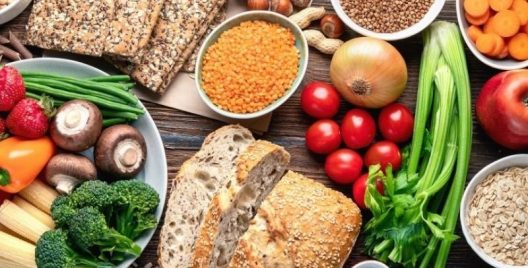Babies – Newborn to 6 months
Infants usually double their length and triple their weight between birth and one year of age. Breast milk generally supplies a baby with the required amounts of nutrients, fluids and energy up to about 6 months of age, which is usually the recommended exclusive breastfeeding period. Breast milk is preferred to infant formula wherever possible, as it contains many protective and immunological factors that benefit the baby’s development. In case of individual requirement, appropriately prepared infant formula can be used.
6 months to 1 Year
To meet the infants’ increasing nutritional and developmental needs, they should be gradually introduced to common foods as adults. However, breastfeeding should be continued till 1 year of age or beyond, or for as long as the mother has adequate secretion or till the child desires. Culturally appropriate foods and preparation methods should be encouraged as long as they are nutritionally adequate. The baby should be gradually weaned from breast or bottle feeds and new foods should be introduced starting from clear liquids (e.g. clear vegetable juice), full liquids (e.g. milk), semi solids (e.g. porridge), soft solids (e.g. well mashed rice) and then the solid foods (e.g. idly).
Toddlers
Once the child starts eating solids, offer a wide range of foods to ensure adequate nutrition. Like energy needs, a child’s need for protein, vitamin and mineral also increase with age. Repeated trial with foods and choices may be required for a child to accept the new food. Appropriate weight gain and development will indicate whether the food intake is appropriate. Food-related problems for young children include being overweight, obesity, tooth decay and food sensitivities. By the time they cross 1 year of age, children prefer to eat with their finger. Hence the food items have to be grip friendly and easy to hold. Some of the toddler super foods include cooked sweet potatoes, cut fruits, vegetable salads, eggs, nuts, paneer/tofu cubes, kebab varieties, tikias and finger foods.
Adolescence and Teenage
The growth spurt, as children move into their adolescence, needs plenty of energy and nutrients. For girls, this generally occurs around 10 to 11 years of age and for boys it occurs later, at around 12 to 13 years of age. During this phase, a child is going through many changes in his/her body – hormonal, skin, height, weight, etc. The child observes these changes and makes amendments in the eating habits without appropriate guidance. The extra energy required for growth and physical activity needs to be obtained from foods that also provide nutrients instead of just empty calories. Takeaway and fast foods need to be balanced with nutrient dense foods such as wholegrain breads and cereals, fruits, legumes, nuts, vegetables, fish and lean meats. Milk, yoghurt, curd and cheese (reduced fat) should be included to boost calcium intake, which is especially important for the growing bones. Cheese should preferably be a low salt variety. This is the time to inculcate food and exercise habits which ensure good health forever.
Young Adults
This is the most fascinating stage in one’s life juncture, where he/she gets transformed from the child cadre to adulthood. Moving away from home, starting work or study, and the changing lifestyle can cause dietary changes that are not always beneficial for good health.
Like all people, young adults require a balanced diet that incorporates fruits, vegetables, dairy, meats, proteins and healthy fats. Calorie requirements for young adults are higher than those for older adults.
Wholegrain breads, pastas, cereals and rice also provide healthy sources of carbohydrates and fiber without excess starch and sugars. Healthy fats, such as olive oil and sunflower oil, can be used for cooking and to create lighter, healthier sauces and dressings. Young adults should monitor their intake of processed and packaged foods, as these items often tend to be high in both sodium and unhealthy fats. Eating well-balanced meals that fall within the nutritional standards will help young adults avoid health risks such as high blood pressure, high blood sugar or high cholesterol as they move toward middle age.
Pregnancy and Lactation
From time immemorial it has been widely understood that a pregnant and lactating woman should concentrate in increasing her nutrient intake, rather than the calorie intake alone, particularly in the first and second trimester. One of the most important determinants of the baby’s health and development is the mother’s diet. Regulation and attention to the diet should begin before pregnancy. It is essential that you be at an optimal weight – neither under nor over weight – before you become pregnant. You should preferably have no vitamin or mineral deficiencies prior to pregnancy. The nutritional relationship between the mother and child continues for some more time after delivery. The newborn baby is given only breast milk for the first 3 months of life so the mother’s diet should be adequate with all needed nutrients. Nutritional needs increase during lactation because for three major reasons – for producing sufficient breast milk for the infant, for providing enough nutrients for the growing infant and for the mother’s daily requirement.
Menopausal stage
Every woman experiences different menopause symptoms. Most women have some hot flashes, some feel irritable, a smaller number of women battle headaches, nausea or night sweats. Whatever your menopause symptoms be, smart food strategies just might help make your years around menopause a little more comfortable. Eat more tofu and soy, be a grazer and not a gorger, avoid high fat, high sugar foods, choose the beverages wisely, add flaxseeds to your diet regularly and follow a systematic physical exercise pattern. Aging does not have to equal weight gain. Women do tend to put on .5 to 1 kg a year in their 40s and 50s, but it is more likely due to a drop in activity rather than hormones. Thinning of bones is common in post-menopausal women because of hormone related changes. So be open to adequate amounts of milk and milk products.
Old age
Many people eat less as they get older. This can make it harder to make sure your diet has enough variety to include all the nutrition you need. Remain healthy with well-balanced eating and regular exercise. Eat foods that are nutrient dense rather than energy dense, including eggs, fish, low fat daily products, nuts and seeds, legumes, fruits and vegetables, wholegrain breads and cereals and lean meats. Limit foods that are high in energy and low in nutrients such as cakes, sweets and soft drinks. Choose foods that are naturally high in fiber to encourage bowel health. If possible, try spending sometime outside each day to boost your Vitamin D synthesis for healthy bones. Be as active as possible to encourage your appetite and maintain muscle mass.














